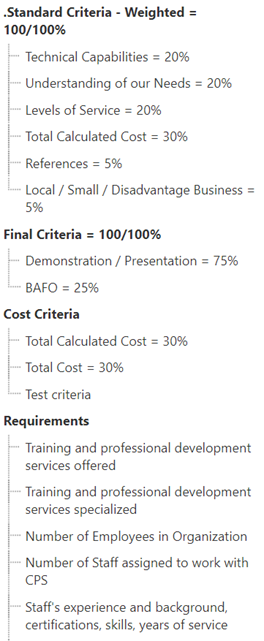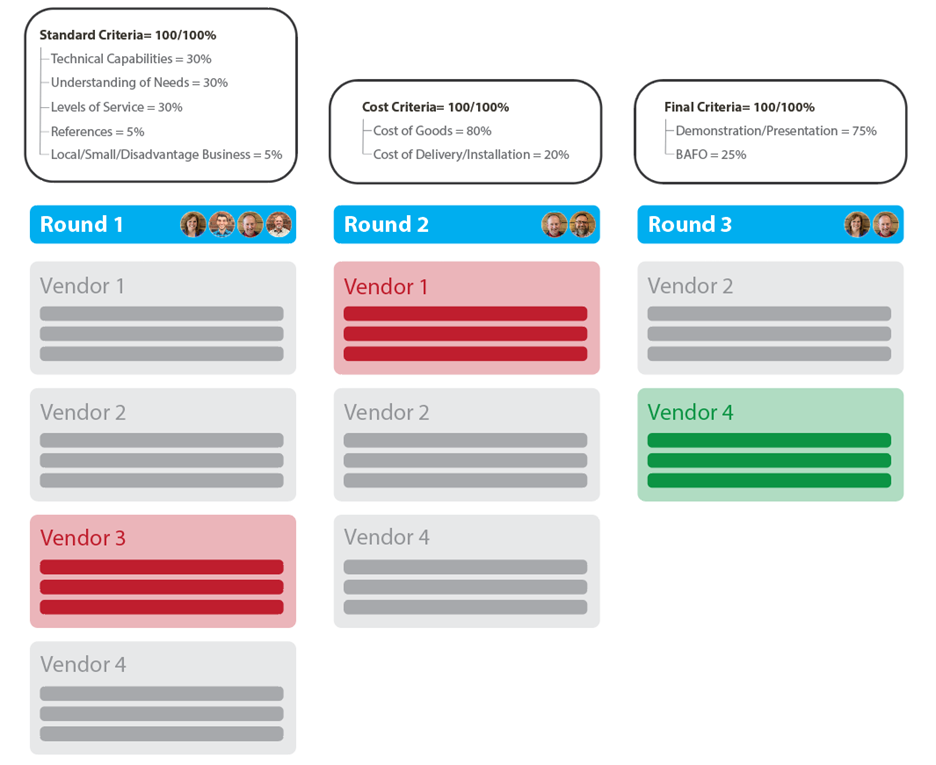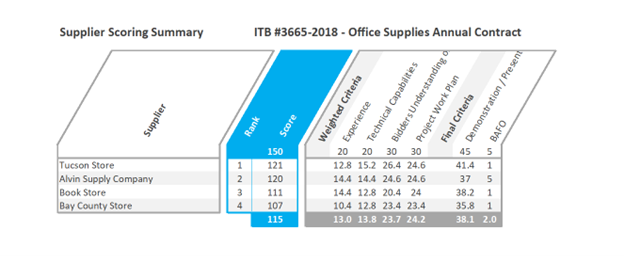Welcome to the second instalment of The New Purchaser’s Guide to Public Procurement—a blog series we’ve created to help each new procurement professional learn the basics of public purchasing before diving into the job.
In part one, we covered different types of solicitation documents (RFI, RFQ, and RFP), their uses, and examples. In this blog, we’ll be covering RFP Evaluation Criteria—what that looks like, how to use, and some best practices for RFP scoring.
Let’s refresh on requests for proposals (RFPs) from part one. Agencies use an RFP when they are looking to make a large purchase of goods or services. Once vendors receive an RFP, they can submit their proposal to provide those goods or services. After a standard time period, a public procurement team gathers all vendor proposals and evaluates them based on set criteria to decide which vendor best meets their needs.
Agencies often use subjective questions on RFPs to get high quality responses from vendors. This can create a complicated vendor selection process, which is why using uniform, organized evaluation criteria are necessary.
What are RFP Evaluation Criteria?
Criteria act as an RFP evaluation guide used to decide which vendor’s proposal is the best fit for the organization. Criteria can include specifications such as cost, timeline, quality of product/services offered, organization experience, customer feedback, etc.
RFP criteria help ensure the agency chooses the vendor that meets all their qualifications in the most cost-effective and efficient way possible.
Using evaluation criteria helps a team of evaluators assign a quantifiable score to different aspects of a vendor proposal and choose the vendor through a more objective lens. Developing uniform criteria for a project means evaluators measure vendors in the same way, which is a key element of the public procurement evaluation process—fairness. If evaluation criteria are always different or changing, it could result in choosing the wrong supplier or a vendor contesting an outcome.
Weighting RFP Criteria
RFP criteria are unique for each RFP issued, and some criteria are more important than others. By changing the weight of criteria, you are changing the number of points assigned in categories based on the ranking of a supplier.
Typically, procurement teams make all the weights add to 100 so they can easily create a weighted percentage for each category.

RFP Evaluation Scoring Rounds
RFPs often involve many responses from potential suppliers and can be overwhelming to evaluate. RFP questions also tend to be lengthy, requiring long review times. One way you can reduce the amount of stress involved in the scoring process is to split the evaluation into scoring rounds.
Often, the first round of scoring has scoring guidelines that provide a more general evaluation. The final rounds work with the key details of vendor proposals to decide the successful vendor. Each round can have different evaluators to allow those with technical expertise to evaluate the criteria they’re most familiar with.
For example, when purchasing a software solution, involving an IT manager in the evaluation of security for each system to determines if a solution meets the organization’s security standards.

In the example above, a public agency is looking for construction management software. The first round of evaluations consists of the weighted criteria of technical capabilities, understanding of agency’s needs, levels of services, references, and whether it’s a local, small, or disadvantaged business. This phase narrows down the list of vendors that don’t meet general requirements.
The second round consists of cost criteria, such as the cost of the software itself, implementation, and training.
The final round evaluates the vendors’ demonstrations, presentations, and their best and final offer (BAFO). After the list is narrowed down further, the evaluators can look at these more detailed criteria to select the best supplier.
How to Use an RFP Scoring Matrix
An RFP scoring system consists of a set of evaluation criteria, each assigned a certain point value and weight. A vendor’s proposal is then scored on these criteria and the total points tallied up to decide on the winning proposal. This method helps make sure all scoring expectations are the same and that no supplier gets an unfair advantage in the public procurement process.

RFP Evaluation Criteria Example
Deciding that the local park needs new equipment for its playground, XYZ City’s procurement team must begin the RFP process. They start off by writing an RFP defining the needs of the playground and the standards and expectations of potential vendors.
Creating clear evaluation criteria is crucial for XYZ City to conduct a fairand effective RFP process. When deciding what evaluation criteria to use, they discovered many factors that play into the equipment selection process. The use of taxpayer dollars, size of the equipment, safety ratings and standards, reputation and references, delivery and installation, and contract terms all play a large role in this purchase.
The park decided to weight their criteria as follows:
- Pricing = 30%
- Safety Ratings = 20%
- Delivery and Installation = 20%
- Warranty Terms = 10%
- Reputability = 10%
- Size of Equipment = 10%
Streamline and Manage Your RFP Evaluations with Euna Procurement
Evaluations don’t have to be painful. Euna Procurement’s centralized eProcurement system is built for public procurement teams to develop RFP evaluation criteria, provide feedback, and score RFPs all in one place.
Book a demo today to learn more!